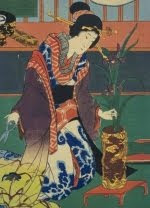Four Girls in Åsgårdstand, from 1902, is one of Edvard Munch's more harmonious motives. It exists in several versions dating from the same periode. Twenty years later Munch painted the four girls once more. This time as one of 12 paintings for the Freia Hall where the yearly Rose Days ikebana exhibition takes place. Munch reused his motives, this time in a more optimistic colour scheme.
"Four Girls", miniature ikebana.
Thistle and Astilbe, Rosebud and Verbena,
Echinacea and Freesia, Cosmos and Maple.
I've tried to catch the spirit of the four girls posing for the artist in this set of miniature ikebana, by putting together parts from different flowers in new ways. Miniature ikebana was introduced as a new style in the 1950s by Sofu Teshigahara, founder of the Sogetsu School of ikebana. Later Sofu's daughter Kasumi Teshigahara developed the miniature style and made it one of her trademarks. Originally minitaure ikebana were made in very small containers such as lipstick caps. I'm using small sized Norwegian and Danish midcentury pottery for this set, which makes the arrangements a bit larger than the original style.

Munch painted many of his well known paintings in the small town Åsgårdstrand where he had a house. He said walking around in Åsgårdstrand was like walking around in his paintings.












No comments:
Post a Comment